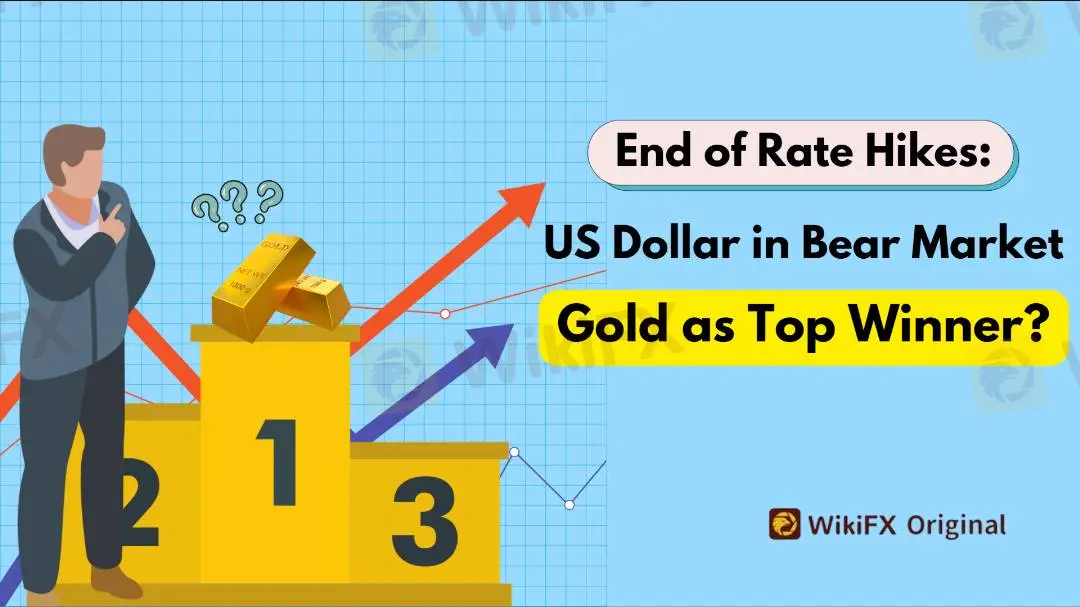简体中文
繁體中文
English
Pусский
日本語
ภาษาไทย
Tiếng Việt
Bahasa Indonesia
Español
हिन्दी
Filippiiniläinen
Français
Deutsch
Português
Türkçe
한국어
العربية
End of Rate Hikes: US Dollar in Bear Market, Gold as Top Winner?
Abstract:As the Federal Reserve's rate hiking process nears its end, an increasing number of financial industry professionals are becoming bearish on the outlook for the US dollar.

As the Federal Reserve's rate hiking process nears its end, an increasing number of financial industry professionals are growing pessimistic about the outlook for the US dollar.
Typically, when the Federal Reserve raises interest rates and increases the level of the federal funds rate, the US dollar index tends to rise. Conversely, if the Federal Reserve cuts interest rates, the US dollar index typically declines.
Economists at Wells Fargo Bank anticipate a moderate depreciation of the US dollar in the fourth quarter of this year, with an accelerated depreciation expected next year. In the short term, the US dollar may remain relatively stable due to further tightening of monetary policy by the Federal Reserve, coupled with potential minor market turbulence, providing temporary support for the dollar. However, the bank projects that as the Federal Reserve implements aggressive easing policies starting in early 2024, the US dollar will ultimately come under pressure. Wealth Bank forecasts a 1.5% decline in the US Dollar Index (DXY) in 2023 and a further 5% decline in 2024.
A previous report by UBS stated that the impasse in the negotiations on the US debt ceiling would have limited impact on the US dollar. Historical evidence suggests that the debate over a new debt ceiling agreement will continue to surface in the media, but its impact on the US dollar is expected to be limited as the foreign exchange market is forward-looking and assumes that Congress will reach an agreement at the last moment. While the current macroeconomic uncertainty benefits the US dollar, a pessimistic view on the dollar persists. UBS believes that reduced yield arbitrage, a reversal in European trade conditions, and outflows from the US dollar could pose resistance to the dollar in the latter half of the year.
Bank of America's Chief Investment Strategist, Michael Hartnett, stated that the US dollar is currently in its fourth bear market in the past 50 years, and he expects the US Dollar Index to decline by 20% in the long term. At the same time, Bank of America is optimistic about the performance of international gold prices and emerging market equities during the US dollar bear market.
Similarly, China Galaxy Securities pointed out that the US May Markit Services PMI continued to rise, reaching a new high. Coupled with the higher-than-expected year-on-year increase in US April Core PCE, market expectations for a 25 basis point interest rate hike by the Federal Reserve in June have increased. Over the weekend, the two parties in the US reached a tentative agreement on the debt ceiling negotiations, which is favorable for the downward movement of US bond yields and provides support for a rebound in gold prices. Looking ahead, there is still a risk of economic recession in the US, and the Federal Reserve may still have the possibility of cutting interest rates in the second half of the year. After a short-term volatility period, the gold sector is in a favorable position ahead of potential interest rate cuts.
China Futures also analyzed that precious metals are currently facing valuation pressures in the short term. However, in the long term, the interest rate curve is more likely to decline than rise, and the relative strength of the US economy is weakening. Therefore, there is still potential value in allocating to precious metals.

Disclaimer:
The views in this article only represent the author's personal views, and do not constitute investment advice on this platform. This platform does not guarantee the accuracy, completeness and timeliness of the information in the article, and will not be liable for any loss caused by the use of or reliance on the information in the article.
Read more

Top 10 Trading Indicators Every Forex Trader Should Know
Master the top 10 Forex trading indicators to analyze real-time Forex quotes, trends, and market signals. Learn strategies to boost accuracy and avoid mistakes.

Geopolitical Events: What They Are & Their Impact?
You've heard many times that geopolitical events have a significant impact on the Forex market. But do you know what geopolitical events are and how they affect the FX market? Let us learn about it today.

Why Do You Feel Scared During Trade Execution?
Trade execution is a pivotal moment for traders. It is when analysis turns into action, and potential profits or losses become reality. However, for many traders, this moment is accompanied by fear. Why does this happen, and how can you address it?

WikiEXPO Global Expert Interview: Simone Martin—— Exploring Financial Regulation Change
In the midst of financial innovation and regulation, WikiGlobal, the organizer of WikiEXPO, stays abreast of industry trends and conducts a series of insightful and distinctive interviews on pivotal topics. We are delighted to have the privilege of inviting Simone Martin for an in-depth conversation this time.
WikiFX Broker
Latest News
Geopolitical Events: What They Are & Their Impact?
Top 10 Trading Indicators Every Forex Trader Should Know
ASIC Sues Binance Australia Derivatives for Misclassifying Retail Clients
Why Do You Feel Scared During Trade Execution?
Revolut Leads UK Neobanks in the Digital Banking Revolution
Fusion Markets: Safe Choice or Scam to Avoid?
North Korean Hackers Steal $1.3bn in Cryptocurrency in 2024
Currency Calculator


